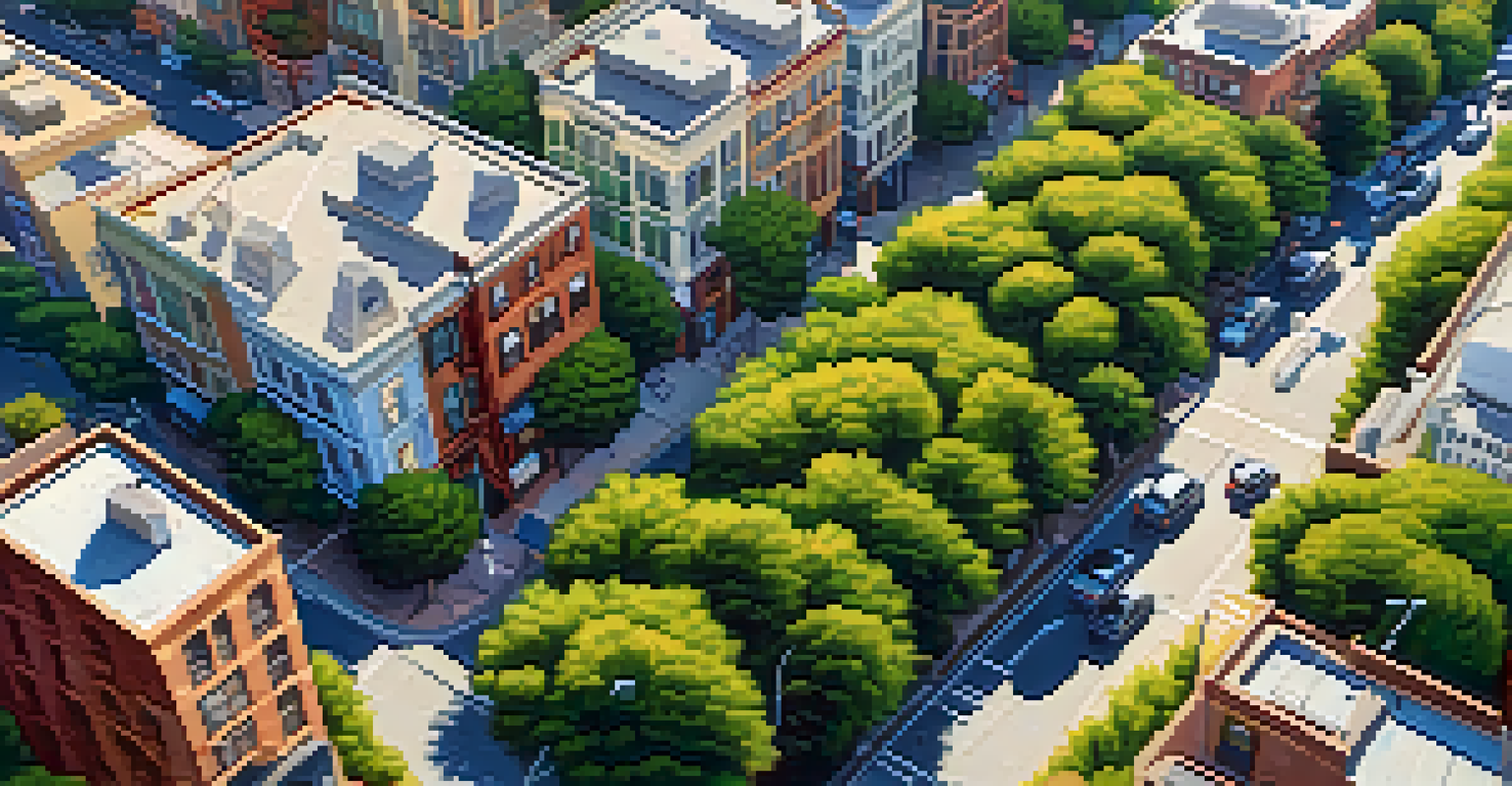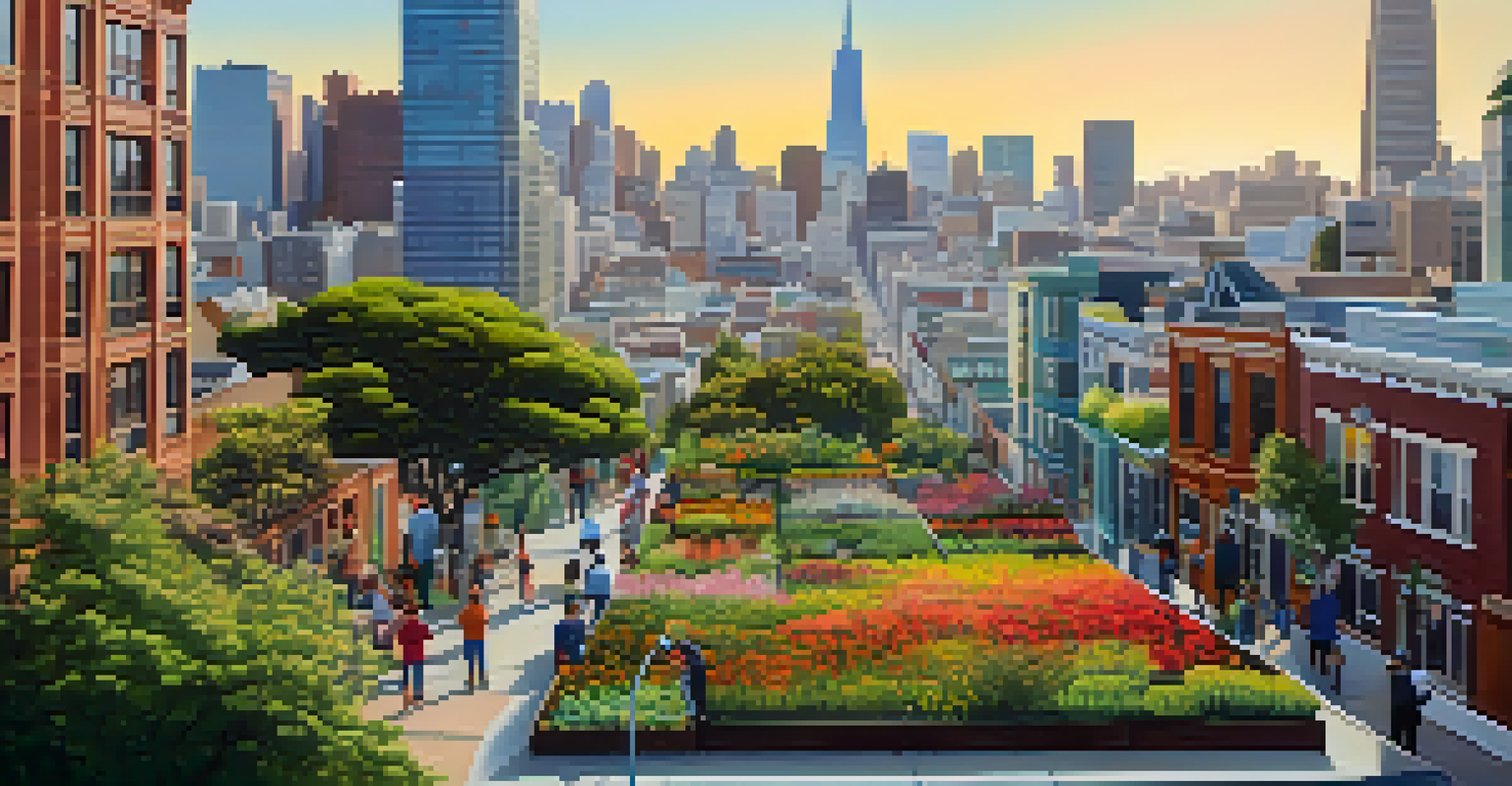The Effects of Urban Development on SF's Microclimates

Understanding Microclimates in Urban Settings
Microclimates are small areas where the climate differs from the surrounding region. In urban settings like San Francisco, these variations can be significant due to factors like buildings, roads, and vegetation. For example, a neighborhood filled with concrete can trap heat, creating a warmer microclimate than nearby parks.
The environment is where we all meet; where we all have a mutual interest; it is the one thing all of us share.
San Francisco is famed for its diverse microclimates, influenced by its topography and proximity to the ocean. When urban development occurs, it can disrupt these natural patterns, leading to shifts in temperature and humidity. Residents often experience different weather conditions just blocks apart, showcasing the city's climatic complexity.
Understanding microclimates is essential for city planning and environmental sustainability. As urbanization increases, recognizing how buildings and infrastructure affect these localized climates can help us make informed decisions for future development.
The Heat Island Effect Explained
The heat island effect occurs when urban areas become significantly warmer than their rural counterparts. This phenomenon is primarily caused by human activities and the materials used in construction, such as asphalt and concrete, which absorb and retain heat. In San Francisco, the dense urban core can experience temperatures several degrees higher than surrounding areas.

As more buildings and paved surfaces replace natural landscapes, the local climate shifts, leading to increased energy demands for cooling. This not only impacts individual households but also strains the city's power grid during peak heat events. Consequently, urban dwellers may find themselves facing higher utility bills in the summer months.
Microclimates Shape Urban Life
Microclimates in urban areas like San Francisco significantly influence local weather patterns and biodiversity.
Addressing the heat island effect requires innovative solutions, such as increasing green spaces and using reflective materials in construction. By doing so, cities can mitigate temperature spikes and promote a more comfortable living environment.
Impact on Local Flora and Fauna
Urban development can significantly alter the habitat of local plants and animals. Changes in temperature and humidity can affect the growth patterns of native species, leading to shifts in biodiversity. For example, some species may thrive in warmer conditions, while others may struggle to survive.
Urban development should be a reflection of the natural landscape, not a disruption of it.
In San Francisco, unique plant communities that have adapted to the local microclimates may face challenges due to urban encroachment. Roads and buildings can fragment habitats, making it difficult for wildlife to thrive or migrate. This disruption can lead to a decline in species that are crucial for maintaining the ecological balance.
Preserving local ecosystems amidst urban growth is vital for sustaining biodiversity. Efforts such as creating wildlife corridors and enhancing green spaces can help support the flora and fauna that define San Francisco's natural heritage.
Air Quality and Urban Development
Urban development can also impact air quality, leading to increased pollution levels. More vehicles, construction activities, and industrial processes contribute to the emission of harmful pollutants. In a city like San Francisco, this can result in diminished air quality, particularly in densely populated areas.
Poor air quality can have serious health implications for residents, including respiratory issues and cardiovascular diseases. Vulnerable populations, such as children and the elderly, are particularly at risk. As urban development continues, it becomes crucial to monitor and address air pollution to safeguard public health.
Heat Islands Strain Resources
The heat island effect in cities increases energy demands and can lead to higher utility costs for residents.
Implementing green infrastructure, such as planting trees and creating green roofs, can improve air quality. These initiatives not only help filter pollutants but also enhance the overall urban environment, making cities more livable.
Water Runoff and Urbanization
Urbanization changes how water is absorbed and flows through the landscape. With more impervious surfaces like concrete and asphalt, rainwater cannot soak into the ground, leading to increased runoff. This can overwhelm drainage systems and contribute to flooding, particularly in low-lying areas of San Francisco.
Moreover, polluted runoff can carry debris and harmful chemicals into local waterways, impacting aquatic ecosystems. This poses a risk not only to local wildlife but also to the quality of drinking water sources. Sustainable urban development practices can help mitigate these negative effects.
Implementing green infrastructure, such as permeable pavements and rain gardens, can help manage water runoff. By allowing rainwater to infiltrate the ground, these solutions reduce flooding risks and promote healthier ecosystems.
Changes in Wind Patterns Due to Development
Urban development can alter local wind patterns, affecting everything from temperature regulation to air quality. Tall buildings can create wind tunnels or block natural breezes, altering how air moves through neighborhoods. This can lead to stagnant air, trapping pollutants and heat in certain areas.
In a city known for its coastal winds, such as San Francisco, changes to these patterns can significantly impact the local climate. Residents may notice a decline in the refreshing breezes that once helped cool their neighborhoods, leading to discomfort during hot days.
Sustainable Practices Are Essential
Implementing green infrastructure and community initiatives is crucial for mitigating the impacts of urban development on microclimates.
Planning for wind patterns in urban design can help mitigate these issues. Including open spaces and strategically placing buildings can promote airflow, ensuring a more pleasant climate for residents.
Community Response and Adaptation Strategies
Communities are increasingly recognizing the need to adapt to the impacts of urban development on microclimates. Local organizations and residents are advocating for sustainable practices and policies that prioritize environmental health. This grassroots movement is essential for fostering awareness and driving change.
Efforts include promoting urban greening initiatives, such as community gardens and tree planting campaigns. These actions not only enhance local biodiversity but also improve residents' quality of life by providing green spaces for recreation and relaxation.

Collaboration between community members, city planners, and environmental groups is crucial for creating resilient urban environments. Together, they can implement strategies that address the challenges posed by urban development while preserving San Francisco's unique microclimates.
The Future of San Francisco's Microclimates
Looking ahead, the future of San Francisco's microclimates will largely depend on urban development choices made today. As the city continues to grow, it faces the challenge of balancing development with environmental sustainability. Innovative solutions will be key in addressing the unique climatic conditions of the area.
Investing in green infrastructure and promoting sustainable building practices can help mitigate negative impacts. This approach not only preserves the city's microclimates but also enhances the overall quality of life for residents, making San Francisco a model for urban resilience.
Ultimately, the goal should be to create a harmonious relationship between urban development and the natural environment. By prioritizing sustainability, San Francisco can thrive while maintaining the diverse microclimates that make it such a unique place to live.